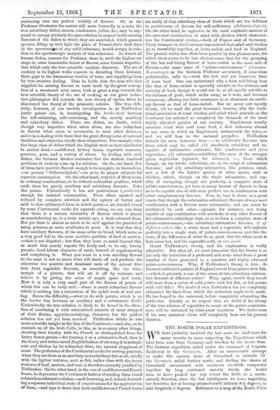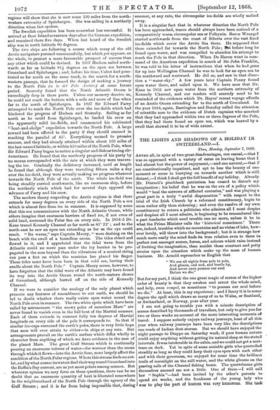THE NORTH POLAR EXPEDITIONS.
WE have probably received the last news we shall have for many months to come respecting the Expeditions which have been sent from Germany and Sweden to the Arctic Seas. The German expedition sailed under the command of Captain Koldewey in the Germania. After an unsuccessful attempt to make the eastern shore of Greenland in latitude 750 the Germania sailed further north, and finding the shores of Greenland encumbered with enormous ice-fields compacted together by long continued easterly winds, she would seem to have pushed her way round the fields in a north- easterly direction, since the last intelligence we have respecting her describes her as having attained north latitude 8(4 degrees, in east longitude 5 degrees. Reference to a map of the North Polar
regions will show that she is now some 120 miles from the north- western extremity of Spitzbergen. She was sailing in a northerly direction when last spoken.
The Swedish expedition has been somewhat less successful. It arrived at Bear Island seventeen days after the German expedition, and remained there five days. When last heard of the Swedish ship was in north latitude 80 degrees.
The two ships are following a course which many of the old Arctic navigators pursued unsuccessfully, but which yet appears, on the whole, to present a more favourable prospect of success than any other which could be devised. In 1607 Hudson sailed north- wards as far as latitude 81i degrees on the open sea between Greenland and Spitzbergen ; and, before his time, Cabot had pene- trated so far north on the same track, in the search for a north- western passage, that he formed the design of making a journey to the North Pole (a lo del Polo Arctic()) at some future period. Scoresby found that the North Atlantic Ocean is exceedingly deep in these parts. Unless our memory deceive us, he could not reach the bottom with a mile and more of line when far to the north of Spitzbergen. In 1827 Sir Edward Parry attempted to reach the North Pole over the ice-fields which had hindered the progress of Hudson and Scoresby. Sailing as far north as he could from Spitzbergen, he landed his crew on the apparently solid ice-fields, and commenced his celebrated " boat-and-sledge" expedition towards the North Pole. A large reward had been offered to the party if they should succeed in reaching the parallel of 85°. Everything seemed to promise success, and they had already attained within about 160 miles of the last-named latitude, or within 850 miles of the North Pole, when Sir Edward Parry began to notice a singular and disheartening cir- cumstance. He found that the northerly progress of his party by lio means corresponded with the rate at which they were travers- ing the ice. Gradually the deficiency increased, until at length he found that although they were travelling fifteen miles a day over the ice-field, they were actually making no progress whatever towards the North Pole of the earth. The whole ice-field was being steadily carried southwards, like an enormous ship, before the northerly winds which had for several days opposed the advance of Parry and his crew.
The modern theory respecting the Arctic regions is that there extends for many degrees on every side of the North Pole a sea which is almost free from ice in summer. It is supposed by some that this sea communicates with the North Atlantic Ocean, while others imagine that enormous barriers of fixed ice, if not even of solid land, surround the Polar Sea on every side. In 1854-5 Dr. Kane traced Kennedy Channel as far north as 81° 22' ; and to the north-east he saw an open sea extending as far as the eye could reach. " Its waves," says Captain Maury, " were dashing on the beach with the swell of a boundless ocean. The tides ebbed and flowed in it, and I apprehend that the tidal wave from the Atlantic could no more pass under the icy barrier to be pro- pagated in the seas beyond than the vibrations of a musical string can pass a fret on which the musician has placed his finger. These tides must have been born in that cold sea, having their cradle about the North Pole." Captain Maury seems, however, to have forgotten that the tidal wave of the Atlantic may have found its way into the Arctic Ocean round the north-eastern shores of Greenland, although barred off on the side of Kennedy Channel.
If we were to consider the analogy of the only planet which presents any features of resemblance to our earth, we should be led to doubt whether there really exists open water round the North Pole even in summer. The two white spots which have been called by astronomers " the snowy poles of moonless Mars" are never found to vanish even in the full heat of the Martial summer. Each of them extends in summer fully ten degrees of Martial longitude on every side of the pole it corresponds to. So that if similar ice-caps surround the earth's poles, there is very little hope that men will ever attain to either—in ships at any rate. But arrangements prevail on the earth's surface which differ wholly in character from anything of which we have evidence in the case of the planet Mars. The great Gulf Stream which -is continually pouring an enormous volume of water—far warmer than the ocean through which it flows—into the Arctic Seas, must largely affect the condition of the North Polar regions. Where this stream finds an out- let, and by what course its waters find their way round Greenland into the Baffin's Bay current, are as yet moot points among seamen. But whatever opinion we may form on these questions, there can be no doubt that an enormous quantity of heat is liberated somewhere in the neighbourhood of the North Pole through the agency of the Gulf Stream ; and it is far from being impossible that, during
1 summer, at any rate, the circumpolar ice-fields are wholly melted away. It is a singular fact that in whatever direction the North Pole has been approached, traces should always have been noticed of a comparatively warm circumpolar sea or Polhynia. Baron Wrangel started northwards from the coast of Siberia over the vast fixed ice-fields which cover the Arctic Sea there. He supposed that these extended far towards ther North Pole ; rittt before long he found open water, and was compelled to abandon his attempt to reach the Pole in that direction. When De Haven went in com- mand of the American expedition in search of Sir John Franklin, he was told in his letter of instructions that when he had gone far up into Wellington Channel he was to look for an open sea to the northward and westward. He did so, and saw in that direc- tion a "water-sky." A few years later Captain Penny found open water there, and sailed upon it. We have seen that Dr. Kane in 1855 saw open water from the northern extremity of Kennedy Channel, and our readers will scarcely need to be reminded of the evidence which Dr. Hayes' recent voyage affords of an Arctic Ocean extending far to the north of Greenland. In the year 1818, again, Barrington and Beaufoy called the attention of scientific men to the evidence of Dutch captains who asserted: that they had approached within two or three degrees of the Pole, that they had there found an open sea, which was heaved by a swell that showed it to be of wide extent.































 Previous page
Previous page